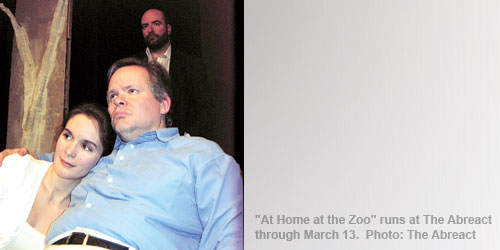
In 1958, Pulitzer Prize-winning author Edward Albee wrote his first play, "The Zoo Story," which to this day is still considered one of his signature pieces. The story of two strangers who meet and chat on a park bench in New York's Central Park, the play ushered a new approach to storytelling into the American Theater – yet theatergoers and critics alike often found fault with one particular aspect of Albee's story: little insight is revealed about one of the play's two characters. The playwright agreed, and almost a half-century later that flaw was fixed with the premiere of "Homelife" – both of which are given riveting productions at The Abreact Performance Space on the fringe of downtown Detroit under the title Edward Albee's At Home at the Zoo.
In "Homelife," we're introduced to Peter and Ann, who live in an upscale apartment on New York's East Side. A seemingly happily married couple of 20 years or so, it's a "safe, familiar voyage" in which neither partner rocks the boat. Instead, their conversations and sex life are routine and unencumbered by passion. But cracks develop when what starts as a typical encounter in the living room begins to strip away their long-held facade.
"The Zoo Story" then follows Peter to Central Park, where he's gone to enjoy the rest of the afternoon by reading a book on his favorite park bench. He's interrupted by Jerry, a friendly but eccentric boarding house resident who wants to strike up a conversation. Amused by Jerry's demeanor and persistence, Peter puts his book down and focuses his attention on Jerry. But what starts as a casual encounter becomes a life-changing crisis for Peter.
What ties the two one-acts together isn't just Peter's participation in both. Rather, it's Albee's examination of class, society and mankind's constant battle to reign in its animalistic nature. In the first act, we meet two comfortable, upper-middle class people who have everything they want – except Ann longs for Peter to occasionally become an animal in bed. However, that's against his nature, he explains. But in the second act, the animal within Peter is unexpectedly drawn out by a person well outside his comfort zone.
Albee, the father of the American absurdist theater, is in top form with both plays – despite the almost 50-years between their creation. Albee wastes few words in his scripts; both are tightly constructed with dialogue that sparkles with wit and insight into the human condition.
At the same time, though, there's little action in either play – at least until the climax of "The Zoo Story" – and that often makes for a dreadfully boring night of theater. But not in the hands of directors Adam Barnowski and Andrea Smith, who have coaxed finely tuned performances out of their three actors.
That's especially true of Dave Davies, who moves out of the safety of his own comfort zone – comedy and improv – to tackle the role of Peter. His comedic sensibilities are greatly exercised in both plays; his timing is perfect, as is the shading he gives to the dialogue's multiple layers of subtext. (Much of the night's humor is the result of his spot-on line delivery, beginning with his opening line of the night, "We should WHAT?" It's such a simple sentence, but so effectively rendered that it helps set the tone for the rest of the performance.) He's most impressive in "The Zoo Story," however. His role through much of the play is reactionary – which is what generated much of the complaints about the show over the years. But watch Davies' face and body language throughout the play: He is totally focused on Jerry, and he responds to everything the character says as if he really IS hearing Jerry's stories for the first time. And the stunning climax is powerfully portrayed.
Plus, he works especially well with Charles Reynolds in "The Zoo Story." Reynolds, who loves to tackle the theater's most unusual or conflicted characters, storms the stage as Jerry – "a permanent transient" – and never stops. It's a thoughtful, well-crafted performance, with carefully delineated gestures, facial expressions and movements that brilliantly create an unforgettable character that will make you think twice about ever talking to another stranger again – in a park or anywhere else.
Davies is also believable as the husband of Ann, played quite nicely by Anne Marie Damman. But their acting styles sometimes clash: Davies is a laid-back, naturalistic performer, whereas Damman appears to be more methodical and planned in her approach – the result of which sometimes made her look like she was "acting" on opening night. (That was especially noticeable when Peter was telling a curiously excited Ann about a college sex romp; her reaction seemed forced.) And it became somewhat disconcerting to have Damman delivering much of her dialogue straight out to the audience instead of to her husband. (Her often-tight focus on something in the house made it look as if someone else was in the room with them – and she was talking to him or her.)
Those minor quibbles, though, take little away from an otherwise thoroughly engaging – and powerful – night at the theater.
Michelle Becker's sets – a different design for each play – added to the night's ambience. The apartment – slightly askew because of an errant picture frame – revealed much about the couple in "Homelife." But my favorite design work were the grassy "footies" around all four legs of the park bench in "The Zoo Story."
REVIEW:
'At Home at the Zoo'
The Abreact Performance Space, 1301 W. Lafayette Blvd., #113, Detroit. Friday-Saturday through March 13, plus Sunday, Feb. 28. Admission by donation. 313-378-5404. http://www.theabreact.com










